We managed to track down a true equestrian adventuress. Caroline Moorey, from the UK, speaks to us about what it’s like to ride horses in India. Learn about the incredible charity that helps bring snaffle bits to the horses in need. And find out how you can travel on a horse riding holiday in India. Caroline shares with us why the Marwari breed is so special (and why you have to travel to India to ride one)! Find out about some of the most unusual things she’s encountered from horseback. Because let’s face it, where else can you see camels, fortresses, palaces, cows, colorful sari’s and yes, even leopards. This is India!
Author: Krystal Kelly
Question: Please introduce yourself. Say where your from and a little history about you and your horse riding program in India.
I’m Caroline Moorey and my company is Horse India. I am based in the UK and run horse safaris in Rajasthan riding the Marwari breed across the Thar desert and surrounding countryside.
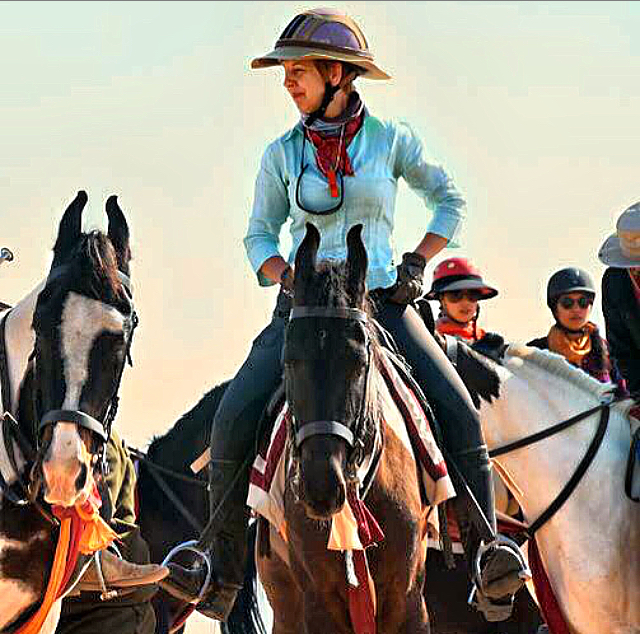
[wordads]
Q: What made you start a horse riding holiday in India?
My first visit to India was on a riding holiday in 2004. Back then my interest in the breed was sparked. Soon the IHSI (Indigenous Horse Society of India) approached me to form a UK chapter and promote the Marwari breed to a wider audience. Initially it was groups of like-minded friends on “Bit Delivery Trips” to promote our Bit Donation Scheme welfare project. Later I focused on improving the whole guest horse safari experience. As a result Horse India was formed in 2015.
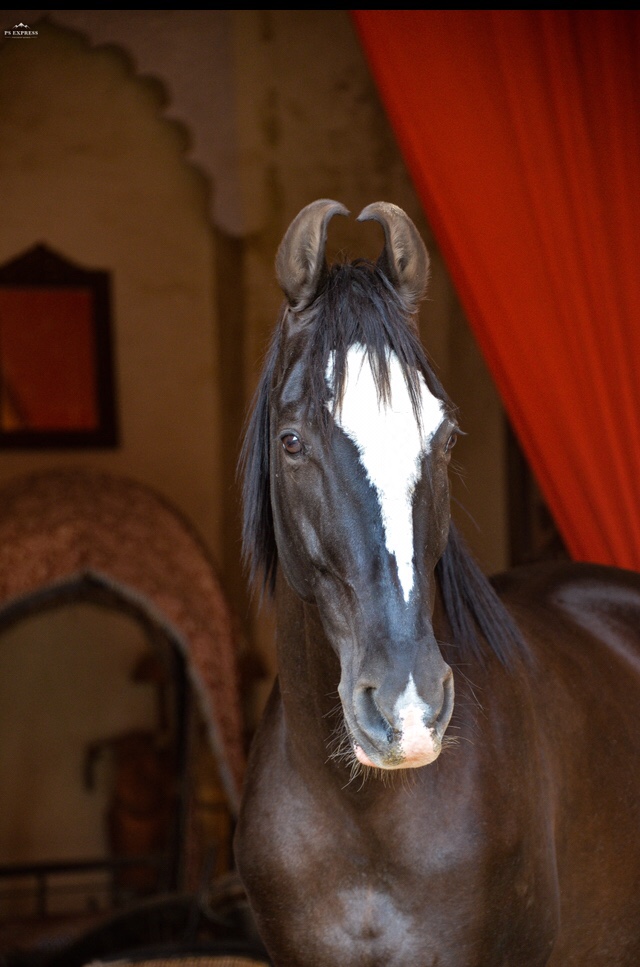
Q: What did you feel when you traveled to India the first time? What made you keep coming back?
I had competed and kept horses at home in the UK for 25 years but India was my first horse holiday. It was exciting and I can’t explain, but of all the riding holidays around the world I was only drawn to Rajasthan. Its desert location and the unique Marwari horse breed were calling me. I trained in Graphic Design and my parents are designers too. That’s why I loved the vibrancy of the colors, the wonderful photographic and visual opportunities, the culture and traditions. The people were so friendly and I could see there was opportunity to improve the breed and educate the Indian equestrian community, and more importantly that they were eager students. I have always felt it a duty to pass on knowledge where one can.
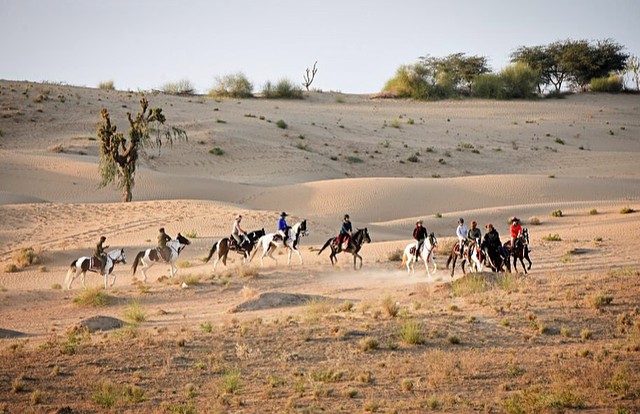
Q: What is it like riding marwari horses?
I love them! They are spirited but safe. They are willing partners, always keen, and soft to the hand and leg. Furthermore they are up for any challenge, whether that is walking all day in the heat or galloping and weaving hilariously at speed through thorny acacia bushes trying to follow a BlueBull antelope. Marwari have the most fantastic active walk – they would get top marks in dressage for their “walk with purpose!”
[wordads]
Q: What is the weather / terrain / environment like? What kind of trails are you riding or sights do you see and experience? Are you camping/staying in hotels?
At Horse India we offer a mixture of holiday options with our rides. Each one is curated to give our riders the best experience in the chosen location. And each ride is completely different to all our other rides. For example, you can ride down the Aravalli hills working your way through the quiet and dappled shade of the Kumbhalgarh and Ghanerao forests, staying in heritage castles and small family country palaces. You can ride the plains, through farmland and villages and smooth rocky outcrops, camping by lakes whilst looking for leopards. Or you can canter over sand dunes in the Great Thar Desert, sleeping under the velvet night sky.

The best season is October to March. The daytime temperatures ranges from 25 – 35°C and night time ranges from 5 – 25°C depending on which month. All our rides include insights into the local culture and traditions. So we may stop off on a ride to visit a local temple, join in festivities, fairs, religious or wedding processions, as well as include a day at the major sights in the cities of Jodhpur and Udaipur. But it is the free riding in the countryside that takes precedent! Our rides are primarily aimed at riders who want to spend maximum time on the horse.

Q: What’s the biggest challenge you’ve faced having a horse riding tour company in India?
I have been very lucky to have partnered with Dr Rao Ajeet Singh, who has a stable of over 50 Marwari. Without Ajeet’s enthusiasm, contacts, local knowledge and ambition I feel I may have encountered a lot more without his guidance.

On a day to day level a lot of time is spent befriending local farmers, garnering local knowledge, meeting village chiefs, local police departments etc. We do this in order to smooth our ride routes. That way we know that we have help along the routes should it ever be required.
Q: You bring bits to India for some of the locals. Can you tell us more about that?
Yes! I am the founder and Chair of the UK chapter “Friends of Marwari / Kathiawari Horse UK”. We run a Bit Donation Scheme. Our aim is to provide an alternative to the cruel sharp homemade “thorn” bits found in the rural areas. Horse owners in India just don’t have access like we do to smooth snaffle bits currently.
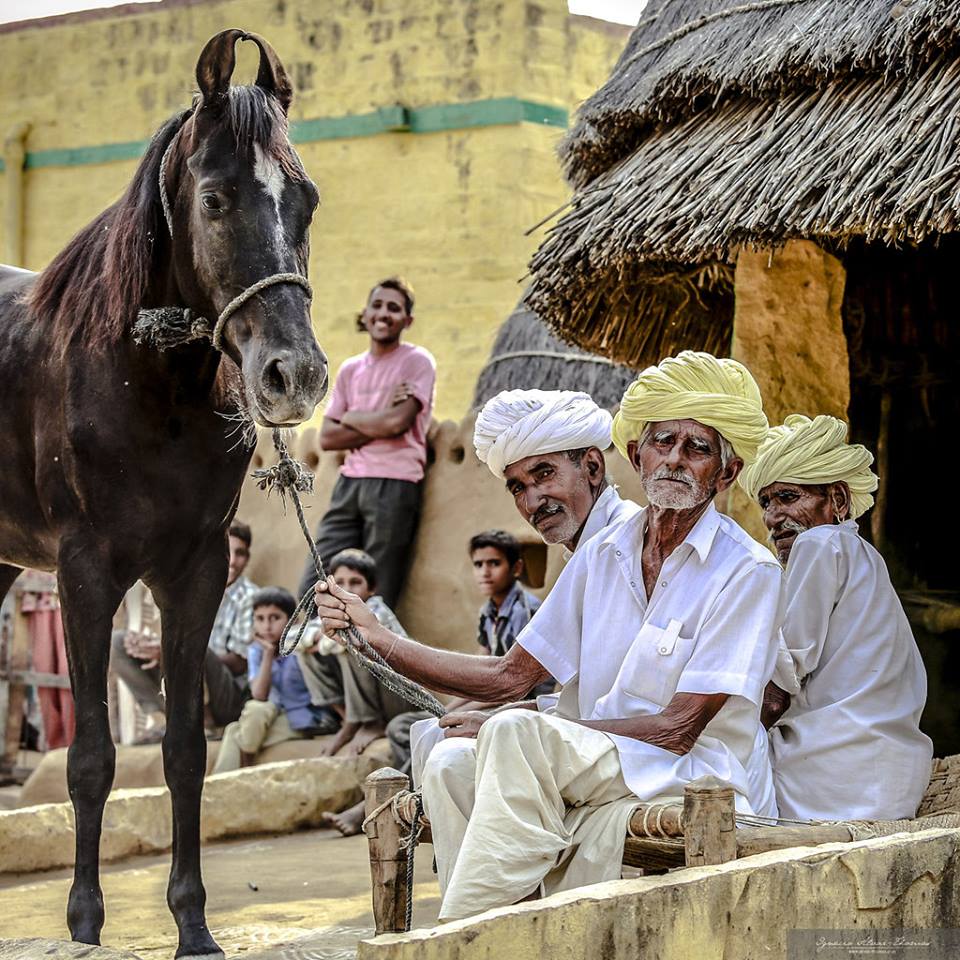
Since 2010 we have donated over 3,000 smooth bits in over 14 locations and 5 states of Northern India. We have over 60 collection points where people can drop their bits off at saddlers and feed merchants around the UK. By now, France, Germany and Australia have collection points too. It’s a really simple self-funding scheme where people donate their unwanted or used pony bits. Marwari have small mouths so 5” is a good average width. We then collate and sterilize the bits. To deliver we just take them in our luggage on each ride. We hand the bits directly, with education and a smile, to willing rural horse owners at the horse fairs and to any horse owner we meet in villages along our rides. Find out more about the Bit Donation Scheme.
Q: Can you share a memorable experience of yours? (details are welcome!)
Gosh! Too many memorable experiences (all for the good!) I have convened two all lady British teams and have competed successfully with them in India. We could prove that the Marwari breed is excellent for endurance. As we won Team Gold in the 50km and took Team Bronze in the 81km.
[wordads]
I have been on a Hathi Hunt in Jodhpur at rush hour (Hathi = elephant). We lost a wedding elephant that was delivered to the wrong location in Jodhpur. So with the groom and wedding party arriving imminently we drove furiously through the city traffic, taking on board a policeman and sugar cane seller as satnav, to track down the elusive elephant, load her back into the lorry and negotiate her route across town safely (avoiding low bridges) to the back of the wedding procession just in time for her to have her howdah fitted and, with seconds to spare, kneel for the groom to mount, as his colourful and noisy entourage rounded the corner, all blissfully unaware of her eventful journey and near miss.
Q: What does being an “Equestrian Adventuress” mean to you? What do you like about it?
I have always loved reading tales of lady explorers. And I have been brought up with the belief that anything is possible with a “can do” attitude and a smile. I feel that Equestrian Adventuresses is a wonderful band of like minded ladies. They are open minded, inquisitive and confident, willing to explore other cultures and locations through their love of horses and riding – and that can only be a good thing!

Q: Any advice for anyone interested in riding horses in India?
I’d say the best thing you can bring with you is an open mind. Acceptance – that sometimes things that are done differently are not necessarily wrong. They are just different, and that what may work or be normal practice in your country may not be suitable in another’s country or situation. This is, after all, why you have traveled around the world; to experience an alternative culture.
Q: What is the most unusual thing you saw while on horseback in India?
Haha! Too many! A lumbering “creature” that looked like something out of a Mad Max movie. It was a camel with hobbles on its front legs. Therefore it was effectively 3 legged. It “cantered” (for want of a better word) inelegantly with us for a kilometer before stopping abruptly and staring in awe as we galloped smoothly on.
[wordads]
An impromptu meeting (twice!) during our rides of a traveling storyteller, dressed in full character costume (including heavy stage makeup) who made his living traveling from village to village re-enacting stories from the Mahābhārata and Ramayana. He appeared nonchalantly, colorfully and extremely gaily (in all sense of the word), and seemingly out of nowhere in the midst of the barren desert countryside, and seeing a captive audience slipped immediately into character to enact a full chapter, whilst we all sat wide eyed atop our horses…. Priceless.
Q: Any thing else readers should know about?
Horses
Marwari horses are 15hh – 16hh and slight in build as they are desert horses. We ride in English bridles and use Indian Cavalry “sawar” saddles. You can use a mixture of English riding and neck reining techniques – Marwari are adaptable and quick to learn.
Marwari are on the restricted list for export so importantly you cannot ride this breed outside India! If you want to ride a Marwari – come and ride them in their homeland. The name Marwari comes from their native area, Marwar, Rajasthan.
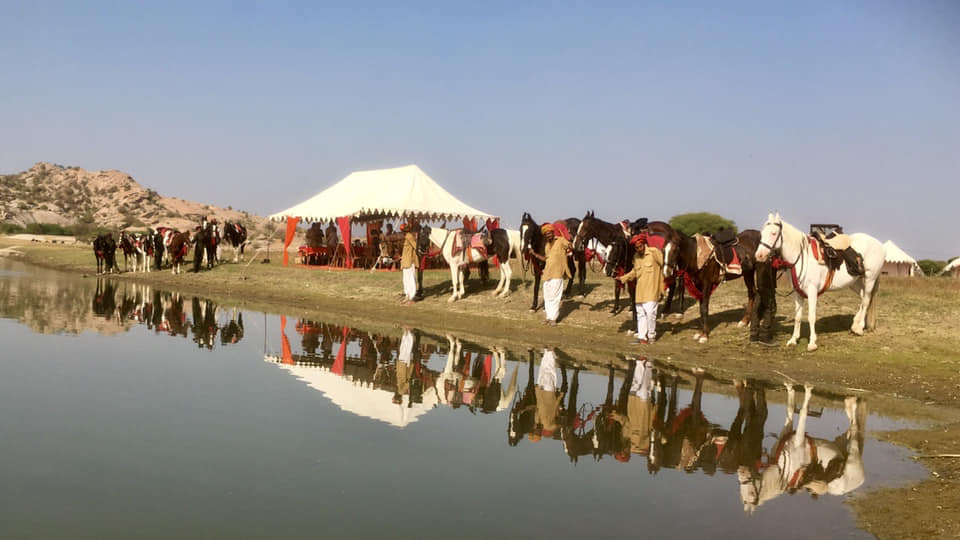
Camping
Many people say they “don’t do” camping. But we use large 14 x 14ft Maharajah “shikar” tents. These tents are erected and dismantled every night by our tent team. You can easily stand up in them. The tents are decorated inside. Each tent comes complete with real beds, linen and an attached private bathroom with a sink, mirror, shower tray and plumbed in porcelain toilet, so please think again!
Find out how to book your next horse riding adventure in India on HorseIndia’s website. If you can’t find the information you need, check out their Instagram channel. You can also contact Horse India via their Facebook page.

Still here? Do want to read more about horse riding in India? Grab a cup of tea and have a look at all the other exciting stories on our website about discovering India on horseback.
